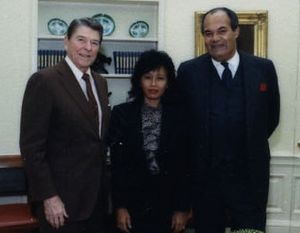Ronald D. Palmer facts for kids
Quick facts for kids
Ronald D. Palmer
|
|
|---|---|

Ronald Reagan, Tengku Palmer and Ronald Palmer in 1988
|
|
| 7th United States Ambassador to Togo | |
| In office 1976–1978 |
|
| President | Gerald Ford |
| Preceded by | Nancy V. Rawls |
| Succeeded by | Marilyn P. Johnson |
| 9th United States Ambassador to Malaysia | |
| In office 1981–1983 |
|
| President | Ronald Reagan |
| Preceded by | Barbara M. Watson |
| Succeeded by | Thomas P. Shoesmith |
| 9th United States Ambassador to Mauritius | |
| In office 1986–1989 |
|
| President | Ronald Reagan |
| Preceded by | George Roberts Andrews |
| Succeeded by | Penne Percy Korth |
| Personal details | |
| Born | May 22, 1932 Uniontown, Pennsylvania |
| Died | April 21, 2014 (aged 81) |
| Spouses | Euna Scott, princess Tengku Intan Bakar of Malaysia |
| Profession | Diplomat |
Ronald DeWayne Palmer (born May 22, 1932 – died April 21, 2014) was an American diplomat. He worked for the United States government. He served as the U.S. Ambassador to three different countries. These countries were Togo (from 1976 to 1978), Malaysia (from 1981 to 1983), and Mauritius (from 1986 to 1989).
Contents
Early Life and Education
Ronald Palmer was born in Uniontown, Pennsylvania. He finished high school in Detroit between 1947 and 1949. After high school, he went to Howard University. He earned a Bachelor of Arts degree in 1954. His main subjects were French and Economics.
In September 1954, Palmer became a Fulbright Scholar in France. He started teaching at the Institute of Political Science. This was part of the University of Bordeaux. In 1955, he won a special scholarship. This allowed him to study for his Master's degree. He attended the School of Advanced International Studies (SAIS). This school is part of Johns Hopkins University. He graduated in 1957.
A Career in Diplomacy
Ronald Palmer began his career as a Foreign Service Officer in 1957. This meant he would represent the U.S. in other countries. His first job was in the State Department. He worked on research for the Far East. This included countries like Laos and Cambodia. He also started learning the Indonesian language.
From 1960 to 1962, Palmer worked at the U.S. Embassy in Jakarta, Indonesia. He was part of the Economics Section. In October 1962, he moved to Kuala Lumpur, Malaysia. He worked there as an economics officer. He had to leave early in June 1963 because his wife was ill.
Later, from 1964 to 1965, he worked in Washington D.C. He was a staff aide to an Assistant Secretary. From 1965 to 1967, Palmer was a cultural affairs officer. He worked at the U.S. Embassy in Copenhagen, Denmark. He even wrote speeches for the Ambassador there.
Teaching and Special Assignments
Palmer also taught at the United States Military Academy at West Point. He was an assistant professor. In 1969, he did an important study for the State Department. This study looked at changes needed for a 1947 agreement. This agreement was about U.S. military bases in the Philippines. From 1971 to 1975, he worked in Manila. His job was to make sure the agreement was followed.
In 1975, he was chosen to be the Deputy of Human Rights. This was a very important role.
Serving as Ambassador
In late 1976, Ronald Palmer became the United States Ambassador to Togo. He served in this role until 1978. During his time in Togo, the Peace Corps program there was considered one of the best. The U.S. Embassy also worked very well.
From 1978 to 1981, Palmer led the Foreign Service Personnel office. This office manages all U.S. diplomats.
During the Reagan Administration, he was chosen again. He became the United States Ambassador to Malaysia. He served in Kuala Lumpur from 1981 to 1983.
After his time as Ambassador to Malaysia, Palmer worked as a visiting scholar. He was at the Center for Strategic and International Studies (CSIS). This was from 1983 to 1986. While there, he wrote a book. His work caught the attention of the White House and the Department of State.
Because of his work, he was appointed Ambassador again. He became the United States Ambassador to Mauritius. He served there from 1986 to 1989.
Ronald Palmer was also a member of important groups. These included the American Academy of Diplomacy and the Council on Foreign Relations. He was married to Euna Scott and had two children.
Life in Copenhagen
Ronald Palmer lived in Copenhagen, Denmark, from 1965 to 1967. He was the Cultural Affairs Officer there. Before this job, he had already studied Danish for 100 hours. His role was to support young and energetic officers.
He was in charge of the Fulbright Commission. This program helps students study abroad. The commission had a budget of almost $200,000.
Palmer enjoyed the local culture. He went to theater, dance, and music shows. He also gave lectures. One lecture was called "Negro-White Relations In the United States." He gave it at a student club in Copenhagen and at Aarhus University.

